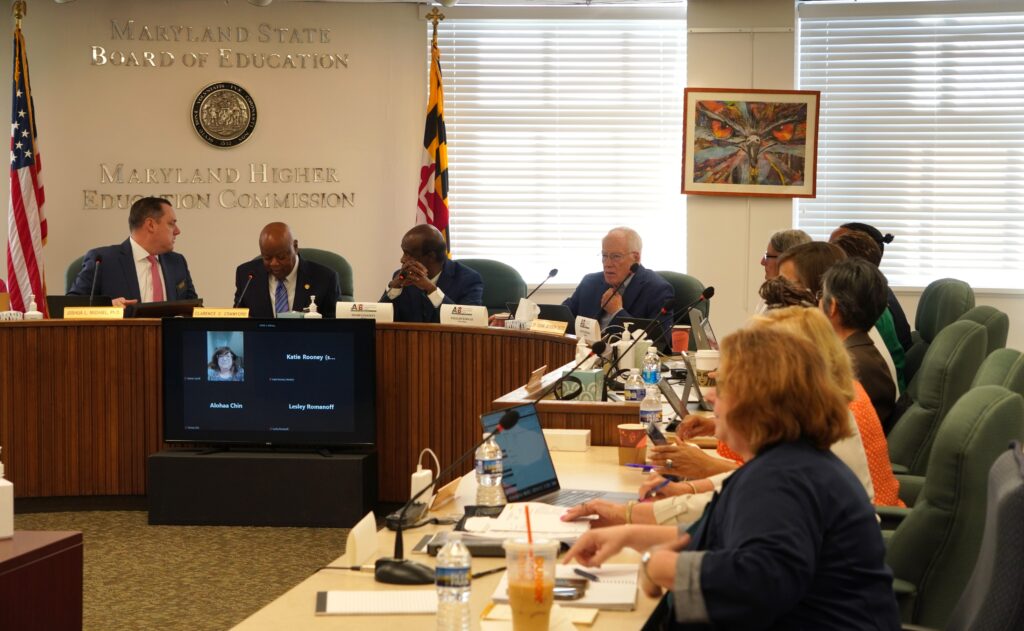The Maryland State Board of Education and Blueprint for Maryland’s Future Accountability and Implementation Board hold a joint meeting June 25 in Baltimore. Photo by William J. Ford.
Two state education boards set aggressive new goals Tuesday for student achievement, attracting and retaining a diverse teacher corps and reducing chronic absenteeism.
It was the second time this year that the Maryland State Board of Education and the Blueprint for Maryland’s Future Accountability and Implementation Board held a joint meeting, and members said their decision to set higher targets is intentional.
“You have to have aggressive targets if you’re going to make that kind of gain,” said William “Brit” Kirwan, vice chair of the Blueprint board and chancellor emeritus of the University System of Maryland, during a break in Tuesday’s meeting.
Of the new goals approved by the boards, the proposed changes to student achievement scores were the most notable.
The boards voted to set a new goal for proficiency in literacy, formerly known as English language arts, from 48% in 2023 to 63% by the 2025-26 school year for all students in grades three through eight.
A look at math proficiency levels. Photo courtesy of Maryland State Department of Education.
The goal to improve math proficiency is even more ambitious. For fifth graders, the goal is to increase the proficiency level from 27% to 46% over the same time period. For students in grades third through eight, the proficiency level target would be raised from 23% to 46%.
When “you’ve got an overall proficiency rate of 23% in mathematics, that’s a long way to go to show significant improvement,” said Maryland Superintendent Carey Wright. “If you don’t set ambitious goals, you’re never going to reach them. And if you set a low bar, that’s what you’re going to get.”
Wright told state lawmakers this year that one of her educational targets is to get Maryland in the top 10 in the National Assessment of Educational Progress (NAEP), also known as the Nation’s Report Card, by 2027. Currently, Maryland ranks 40th.
Besides student achievement, the state also wants to boost teacher diversity and retention.
About 46% of new teachers hired statewide this year were teachers of color. The boards aim to increase that to 55% by the 2026-27 school year.
Schools are currently beating the goal of retaining 70% of teachers of color for three years, with the retention rate now standing at 74%. But both boards voted Tuesday to raise the retention rate goal to 78% in the next three years.
The state also seeks to cut chronic absenteeism by half, from 30% reported in 2022-23 school year to 15% by the 2025-26 school year. Any student who misses 10% of school days is considered chronically absent.
Although state law requires the Blueprint board to make final approvals on any documents, initiatives and proposals in connection with the 10-year education reform plan, it must collaborate with the state Department of Education on expertise to improve learning.
In connection with department goals on workforce diversity, they align with at least one of the Blueprint’s priorities: hiring and retaining high-quality and diverse teachers. The other four priorities, also called pillars, are early childhood education, providing additional resources for students in need, preparing students for college and technical careers and governance and accountability.
Clarence Crawford, who served his last meeting Tuesday as the state Board of Education president, used a football analogy to assess the state’s work to improve overall education.
State Board of Education President Clarence Crawford, left, at a joint meeting with the Blueprint for Maryland’s Future Accountability and Implementation Board, which is chaired by Isiah “Ike” Leggett, right. Photo by William J. Ford.
“What we’re looking to do is to build a dynasty so we’re looking at the culture change necessary to achieve the goal, but also the culture change necessary to sustain the goal,” he said.
“This is not an academic exercise. We’re impacting people’s lives. That’s the magnitude,” Crawford said. “It’s within reach. It’s not going to be easy. There’s going to be bumps along the way, but I believe we can get there.”
Blueprint plans
Both education bodies also discussed included implementation plans Statsubmitted last month from every school district in state to the Blueprint board, also known as the AIB.
In the past week, officials said, department and AIB staff reviewed plans from all 24 school districts with suggestions to revise the plans.
The May documents are a follow-up to brief March reports in which school officials responded to at least five questions and prompts from the state on the top challenges they are facing implementing the Blueprint.
No specific school district was mentioned Tuesday, but some common themes emerged from the plans, include prioritizing stakeholder outreach and involvement, increasing collaboration with school district staff and local schools and identifying supports for students who haven’t met the college and career readiness standard.
Emma Pellerin, implementation plan director with the AIB, said six employees with her agency and 30 staff members with the department reviewed all 24 school district plans.
“It took about 10 hours to just review each plan,” she said during the meeting.
State officials continue to review all school district plans that include possible revisions and other feedback.
Rachel Hise, executive director with the AIB, said to reporters some plans could “possibly” be approved by the Blueprint board July 18.
The post Boards approve ‘ambitious’ goals for student test scores, absenteeism, teacher diversity appeared first on Maryland Matters.

